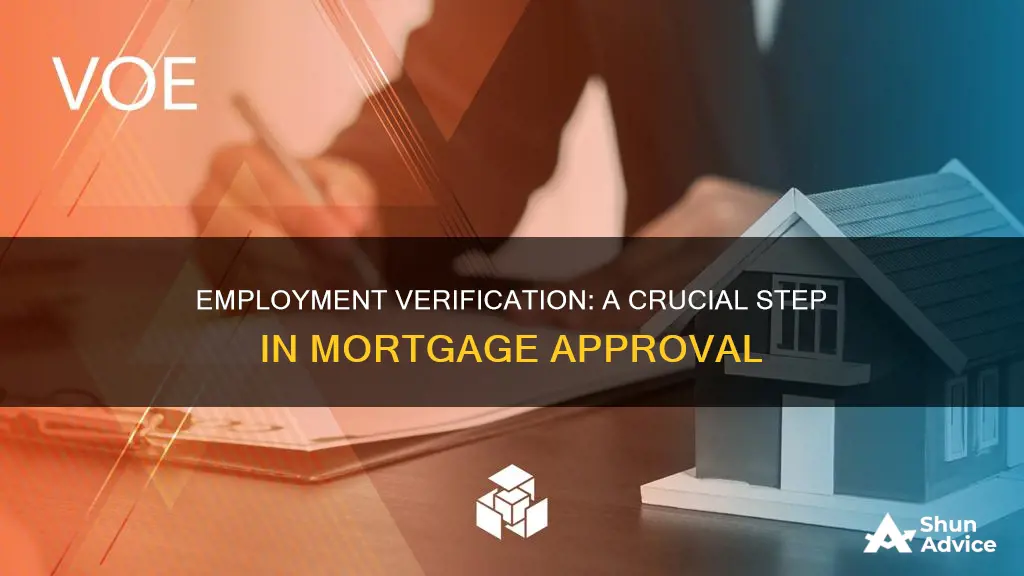
When applying for a mortgage, you'll need to provide your lender with financial information, including your income and employment details. The lender will then verify this information during the underwriting process to ensure you can afford to pay back your loan. This typically happens in the days or weeks before closing, and a second verification may be carried out closer to the closing date to ensure your circumstances haven't changed. Lenders will usually contact your employer directly to confirm the details, but you'll first need to give your permission for them to do so. They may also request additional documentation, such as pay stubs, tax returns, or bank statements, to confirm your employment and financial history.
| Characteristics | Values |
|---|---|
| Purpose | To confirm that the borrower can afford to pay back their home loan |
| Information required | Financial information, including employer and income |
| Documents required | Employment verification letter, recent pay stubs, W-2s, tax returns, bank statements, business licenses, contracts, invoices, etc. |
| Timing | During the underwriting process, which takes place days to weeks before closing; a second verification may be done closer to the closing date |
| Frequency | Lenders rarely verify employment after closing unless there are special circumstances |
| Verification methods | Contacting the borrower's employer, using third-party verification vendors, reviewing documents, etc. |
| Self-employed individuals | May require an IRS Form 4506-T and an attestation of income from a certified public accountant (CPA) |
What You'll Learn
- Lenders verify employment to ensure the borrower can afford to pay back the loan
- Verifying employment is done during the underwriting process
- Lenders may also verify previous employment details
- Self-employed individuals may need to provide additional documentation
- Verbal verification of employment is done before closing

Lenders verify employment to ensure the borrower can afford to pay back the loan
Lenders need to verify a borrower's employment and income to ensure they can afford to pay back their home loan. This process is called the Verification of Employment (VOE) and is done during the underwriting process, which can take a few days to a few weeks. It involves the lender contacting the borrower's employer to confirm details such as job title, time at the company, salary, bonuses, and other income sources. This information is used to evaluate the borrower's debt-to-income ratio and ability to repay the loan. Lenders may also request additional documentation such as pay stubs, W-2 forms, tax returns, or bank statements.
For self-employed individuals, the process can be more challenging as they don't have a traditional employer to confirm their income. In these cases, lenders often require an Internal Revenue Service (IRS) Form 4506-T, which allows them to receive a copy of the borrower's tax returns directly from the IRS. Self-employed borrowers may also need to provide additional documentation such as business licenses, contracts, or invoices to substantiate their income claims.
It is important to note that lenders typically verify both current and previous employment details, especially if the borrower has been with their current company for less than two years. Job stability is an important factor in the mortgage approval process as it indicates income stability. Frequent job changes or gaps in employment can be red flags for lenders and may lead to a higher risk of loan default or buyback requests.
To expedite the verification process, many lenders use third-party verification vendors or automated systems that can complete the process in minutes or hours. However, some lenders may still manually review documents and call employers, which can take longer. Borrowers can also facilitate the process by being proactive, maintaining clear communication, and providing the necessary documentation in an organized and timely manner.
Overall, employment verification is a crucial step in the mortgage lending process as it helps lenders ensure that borrowers have a stable income and are financially capable of repaying their loans. By reducing the risk of default and buyback requests, lenders can make more efficient and informed decisions about mortgage applications.
Cashing Out Refinance Mortgages: Strategies for Homeowners
You may want to see also

Verifying employment is done during the underwriting process
The employment verification process is important for both the lender and the borrower. For the lender, it helps to minimise risk and ensure that they are lending to financially capable individuals. By assessing the borrower's employment history, income sources, and debt-to-income ratio, lenders can determine the borrower's ability to repay the loan. This verification also helps to reduce the risk of loan default and buyback requests. For the borrower, providing accurate and up-to-date employment information can increase their chances of mortgage approval.
During the underwriting process, lenders may request various documents to verify employment and income. These can include employment verification letters, recent pay stubs, W-2s, tax returns, or other proof of employment history. Self-employed individuals may face additional requirements and are often required to provide IRS Form 4506-T, which allows the lender to receive a copy of their tax returns directly from the IRS. They may also need to provide business licenses, bank statements, or other documentation to validate their income and the existence of their business.
To expedite the verification process, many lenders use third-party verification vendors or automated systems that can complete verifications in minutes or hours. However, some lenders may still manually review documents and contact employers directly, which can take longer. It is important for borrowers to be proactive, maintain clear communication, and provide all necessary information to ensure a smooth and efficient verification process.
Additionally, it is worth noting that lenders may perform a second verification of employment closer to the closing date to ensure that the borrower's circumstances have not changed. Job stability is an important factor in the mortgage approval process, and frequent job changes or gaps in employment can raise red flags for lenders. Therefore, borrowers are generally advised to avoid changing jobs during the mortgage loan process.
Strategies for Saving Your Mortgage Down Payment
You may want to see also

Lenders may also verify previous employment details
Lenders will usually verify a borrower's current employment situation, but they may also want to confirm previous employment details. This is a common practice for borrowers who have been with their current company for less than two years. Lenders will typically verify your employment twice: when you apply for a home loan and several days before closing. However, they may perform a third verification after closing under special circumstances, such as suspected fraud or application inconsistencies.
To confirm previous employment details, lenders may contact your previous employer directly and request income information and related documentation. Most lenders only require verbal confirmation, but some may seek email or fax verification. They may also review recent pay stubs, W-2s, or other documents that prove your employment history and confirm your income. This process can be frustrating and time-consuming for both the lender and the borrower.
If you are self-employed, lenders will often require an Internal Revenue Service (IRS) Form 4506-T, which allows them to receive a copy of your tax returns directly from the IRS. They may also ask for attestation by a certified public accountant (CPA) to confirm your income. Tax documents are the primary way lenders research self-employed applicants. It's important to note that Fannie Mae guidelines require self-employed borrowers to have proof of at least two years of earnings to qualify for a mortgage.
In some cases, employers may refuse to verify employment due to state laws or company rules prohibiting the sharing of certain information. If this happens, you should first determine if there is a general rule preventing them from sharing the information. If so, ask your employer to explain this to your prospective lender, as some lenders may be willing to process your application with this understanding. You may also consider finding a different mortgage lender who is more familiar with your state's laws or willing to work with your employer's policies.
Profiting from Real Estate Mortgages: A Beginner's Guide
You may want to see also

Self-employed individuals may need to provide additional documentation
When applying for a mortgage, you'll typically provide the lender with financial information, including your employment and income. The lender will verify this information during the underwriting process to approve your mortgage application.
- Personal and business tax returns
- Bank statements
- IRS Form 4506-T: This is a request for a "Transcript of Tax Return", which allows the lender to receive a copy of the borrower's tax returns directly from the IRS.
- Attestation by a certified public accountant (CPA) to confirm income
- The most recent two years of signed individual federal income tax returns IRS Form 1040
- The most recent two years of business federal income tax returns (IRS Form 1065 or IRS Form 1120S)
- Business financial statements or other documents that demonstrate the financial strength of the business
- Client letters to demonstrate that your finances can handle a loan
The specific documentation required may vary depending on the lender and the borrower's individual circumstances. It's important to note that lenders are assessing the borrower's ability to repay the loan without undue stress on their personal finances.
Real Estate Strategies: Adjusting for Mortgage Rates
You may want to see also

Verbal verification of employment is done before closing
Verifying a borrower's employment and income is a crucial step in the mortgage approval process. It helps lenders determine the borrower's ability to repay the loan and reduces the risk of default. While lenders typically verify the borrower's current employment, they may also confirm previous employment details, especially if the borrower has been with their current company for less than two years.
Verbal verification of employment is a common method used by lenders to confirm a borrower's employment details before finalising the mortgage. This process involves the lender directly contacting the borrower's employer via phone to validate the information provided in the loan application. Lenders are required to call the employer's phone number that can be independently verified by a third party, such as Google. This step ensures that the correct employer is contacted and helps maintain the integrity of the verification process.
During the verbal verification, the lender will confirm various aspects of the borrower's employment, including their position, salary, and work history. They will also ensure that the borrower's circumstances have not changed significantly since the initial application. This process is typically conducted within 10 business days before closing to ensure the information is up to date.
In some cases, lenders may request additional documentation to support the verbal verification. These documents can include employment verification letters, recent pay stubs, W-2s, tax returns, or other relevant information. While verbal confirmation is the most common method, some lenders may also seek email or fax verification for added assurance.
It is important to note that changing jobs during the mortgage application process can impact eligibility. Lenders prefer stability in employment, and a job change may delay closing or, in some cases, cause the deal to fall through. Therefore, borrowers are generally advised to maintain steady employment throughout the mortgage approval process.
Understanding Mortgage Calculations in Connecticut
You may want to see also
Frequently asked questions
Mortgage lenders verify employment by contacting the HR department of your current company and any previous employers. They will likely ask for documents such as pay stubs, W-2 forms, tax returns, and employment letters. They may also require a verbal confirmation from your employer.
If your employer refuses to verify your employment, this could be due to company policy, concerns about liability, or other reasons. You should first contact your HR department to explain the situation and the requirement for employment verification. If this doesn't work, you may need to find a different mortgage lender or consider getting a new job.
Self-employed individuals may need to provide additional documentation such as tax returns, business licenses, bank statements, contracts, or invoices to validate their income and the existence of their business. They may also be required to submit an IRS Form 4506-T, which is a "Transcript of Tax Return", and an attestation of income from a certified public accountant (CPA).







